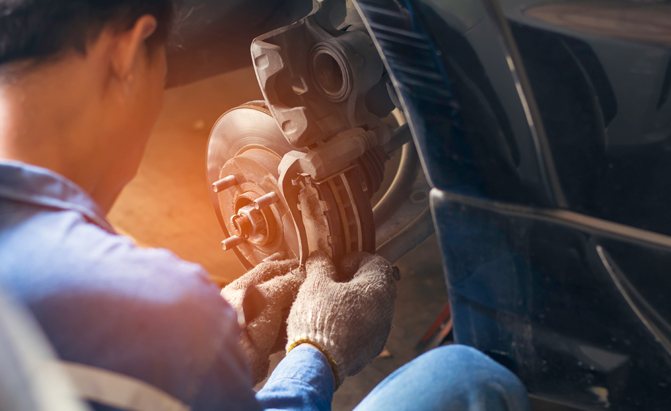
When it comes to maintaining your vehicle, one of the key parts you need to focus on is the brake pads. Good quality brake pads might prevent accidents and ought to be changed periodically. However, finding the top-notch ones can be quite a challenge due to the numerous choices out there covering various price points.
Here’s an overview of suggestions to assist you in making your purchasing process easier. Remember that the majority of brake pads are offered individually for the front and rear sections, so ensure you select the right item for your requirements.
Photo Credit: CC7 through Shutterstock
1. Top Pick: Akebono ProACT Ultra-Premium Ceramic Brake Pad Set (ACT1089)

Check price at Amazon
Even though it might be slightly more expensive compared to some alternatives listed here, Akebono’s ProACT Ultra-Premium Ceramic Brake Pad Set stands out as a top-notch choice for both domestic and Asian vehicle models. As the leading provider of original equipment brake pads to manufacturers across North America, Akebono ensures that their products meet high standards, making them appropriate for most automobile owners.
These brake pads are engineered with vehicle-specific friction formulas aimed at reducing noise, vibration, and harshness while significantly minimizing brake dust. They make excellent replacements for original equipment ceramic pads and can also act as an enhancement over standard pads.
In addition to offering minimal dust accumulation and seamless brake operation, these pads will enhance durability, reducing the frequency of pad replacements.
Pros
Highly trusted brand, premium quality brake pads, very silent operation, enduring toughness
Cons
A small quantity of provided lubricant might result in a lower coefficient of friction compared to certain original equipment brake pads.
2. Top Luxury Choice: Brembo Brake Pads
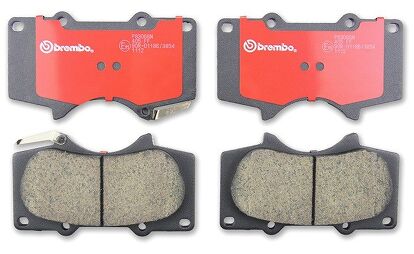
Check price at Amazon
When searching for high-performance brake pads, Brembo stands out as one of the most respected names in the automotive braking sector. Known for their superior quality, these brake pads from Brembo are crafted specifically to improve stopping ability, thereby reducing the distance needed to come to a stop safely and quietly. A hallmark of many Brembo items is their distinctive multi-layer ESE (elastomer-steel-elastomer) red damping shim, which not only signifies authenticity but also aids in minimizing noise and vibration during operation.
A majority of Brembo's products available online consist of ceramic brake pads manufactured via an Original Equipment Direct Molding Pressing Technique. This method employs high-pressure compression to form the friction material accurately onto the backing plate, ensuring optimal compatibility with your car. Following this, Brembo subjects these brake pads to a heat treatment designed to minimize break-in time and performance fade.
Pros
The Brembo brand offers excellent performance; its distinctive red shim reduces noise and lessens vibrations, paired with ceramic pads.
Cons
Price generates quite a bit of brake dust.
3. Most Affordable Choice for Rear Brake Pads: ACDelco Advantage Ceramic Rear Brake Pads (14D698CH)
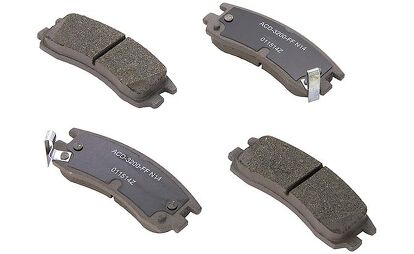
Check price at Amazon
As part of ACDelco’s Advantage Ceramic brake pad series, these cost-effective options deliver excellent performance specifically for the rear brakes. Featuring a ceramic composition with reduced metallic content, they ensure robust stopping power quietly and with minimal dust generation. These pads come in a wide range suitable for virtually every make and model. They employ standard shims, grooves, and bevels to minimize noise, vibrations, and aggressive braking sensations.
These brake pads come ready for installation straight from the package, and most owners express high satisfaction with their performance, particularly considering the cost. They operate quietly, install easily, and generate minimal sound during use. Nevertheless, some customers have reported issues with cracking after purchase.
Pros
Cost-effective, excellent brake performance, silent operation, minimal dust emission, utilizes standard shims, slots, and bevels
Cons
Certain owners have encountered cracking issues with their pads.
4. Quietest Brakes: Wagner Thermo-Quiet
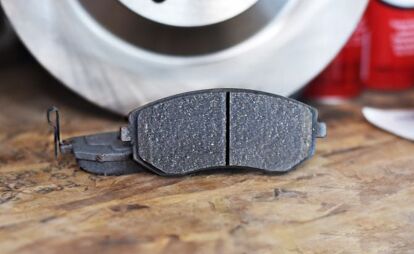
Check price at Amazon
In typical driving situations for most vehicles, you won’t see much variation in performance among different sets of brakes. While certain ones might endure longer or handle tougher usage better, as well as being superior in overall quality, Wagner’s ongoing TQ line offered OE-grade braking performance wrapped in a design meant to minimize brake noise.
The copper-free pad is attached to an underlayment material designed for reducing noise and vibrations, sandwiched between this layer and a steel support plate. These pads feature a laser-cut design with beveled edges aimed at minimizing judder when contacting the brake rotors. They are manufactured using a special OE25 semi-metallic composition that not only surpasses performance of competing products but also generates significantly less brake dust, keeping your rims cleaner.
The Wagner ThermoQuiet brake pads come with a two-year/24,000-mile limited warranty, and many versions also provide stainless steel hardware included.
Pros
As the title suggests, it's quiet and produces very little dust as well.
Cons
Coating chips efficiently, which may result in rust
5. NRS Brakes Zinc-Coated Brake Pads
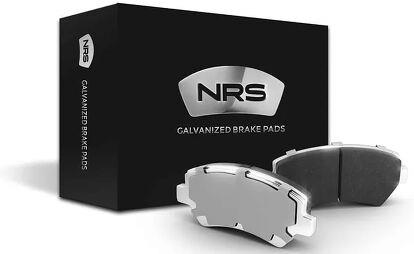
Shop Direct
Following years of providing their proprietary galvanized and mechanical fusion braking systems to major original equipment manufacturers, NRS brakes are finally accessible to regular buyers. This extensive background ensures that NRS Brakes cater to a wide range of vehicle models, with each fitting perfectly upon installation as replacements.
Galvanization involves coating a steel backing plate entirely with zinc to prevent rusting. This matters significantly for brakes because modern brake pads, particularly those produced after-market, often arrive unpainted or uncoated. Over time, debris accumulated during driving conditions can cause these pads to degrade faster than they should, potentially leading to complete separation between the friction material and the backing plate. However, NRS Brakes' galvanized brake systems safeguard against this issue as the zinc-coating prevents the metal components from corroding, thereby allowing the friction materials ample chance to reach their maximum lifespan before needing replacement. NRS Brakes employs advanced mechanical bonding techniques rather than adhesives or glues to secure the friction material onto the backing plates. Unlike conventional methods which may weaken under high temperatures or exposure to dirt and moisture, NRS's approach ensures durability by resisting degradation caused by common environmental stressors encountered within automotive braking mechanisms every day.
There are dual benefits with these products: NRS brake pads not only last longer than conventional ones but also operate quietly and enhance overall stopping power. Additionally, every set of their brakes undergoes testing surpassing what original equipment manufacturers require. Regarding those same OEMs, NRS Brakes stocks all 83 recognized Z Numbers as designated by the FMSI. An application marked with a Z Number indicates that the manufacturer used mechanical bonding for attaching the friction material onto the metal backplate. To top it off, they manufacture everything right here in Canada.
Pros
Innovative technology enhances longevity and functionality, designed for original equipment manufacturer quality fitting, coated with galvanization for corrosion resistance.
Cons
Premium Priced
6. Bosch QuietCast Premium Ceramic Rear Brake Pads (BC905)
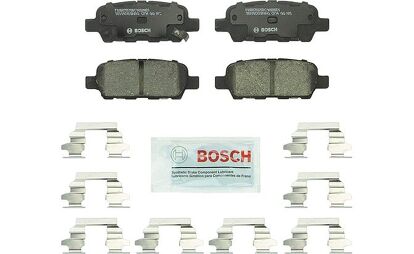
Check price at Amazon
When looking for new rear brake pads, consider putting Bosch’s QuietCast Premium at the forefront of your options. Known widely for their high-quality auto replacements, Bosch frequently supplies original equipment (OE) parts directly to car manufacturers. Their brake pads boast superior stopping ability along with minimal noise during use and reduced brake dust generation.
These brake pads aid in reducing noise thanks to their shim design, which undergoes heating and high-pressure curing sandwiched between dual steel layers, offering reduced sound levels, enhanced durability, and improved rust protection. In terms of performance, Bosch’s QuietCast Premium utilizes an aluminum-based alloy similar to what's employed in aviation technology. Additionally, they are designed without copper and meet the stringent standards set for copper-free regulations expected by 2025.
Designed, validated, and produced in North America, these brake pads probably match your vehicle requirements as Bosch provides superior market coverage for various car models.
Pros
Subtle operation, factory-like grooves and bevels, sophisticated ceramic-based friction material, original equipment-grade rubber center shims, broad compatibility
Cons
There have been some reports of squealing noises, and upon receiving certain brake pads, they were found without wear indicators and/or sensors.
7. ACDelco Professional Ceramic Front Brake Pads (17D1367CH)
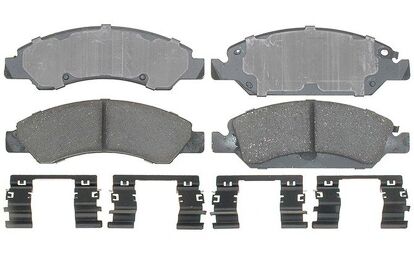
Check price at Ebay
When selecting front brake pads, we recommend those from ACDelco’s Professional Ceramic series. These brake pads undergo rigorous tests according to SAE J2784 standards for their stopping power, along with evaluations concerning noise, vibration, harshness (NVH), and wear resistance to ensure they meet high-quality benchmarks. Incorporating materials like ceramics, semi-metallic compounds, and organics, these brake pads deliver both security and dependability across various vehicles.
To minimize noise, vibration, and harsh braking, ACDelco equips these brake pads with high-quality shims, slots, and chamfers. Additionally, they feature a stamped backing plate that facilitates appropriate pad movement inside the caliper assembly. This stamped component not only reduces noise but also stops pedal pulsation and guards against early deterioration. Moreover, each brake pad’s friction material is directly molded onto the backing plate to ensure robust bonding.
ACDelco stands as one of the most reliable names in the automotive sector and serves as the genuine General Motors Original Equipment parts brand, producing more than 90,000 GM OE and additional components.
Pros
Renowned brand, compliant with SAE J2784 standards, high-quality shims, slots, and chamfers, stamped backing plate, integrally molded, pricing
Cons
A limited quantity of lubricant is supplied, with only a few noise complaints filed.
8. Power Stop Z23 Evolution Sport Front Brake Discs
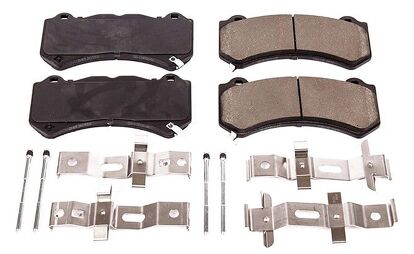
Check price at Amazon
Should you be seeking top-tier performance despite a higher cost, consider the Power Stop Z23 Evolution Sport brake pads. Designed with a carbon-fiber infused ceramic composition, they offer outstanding stopping power and efficiency. The durability of these pads is enhanced by their resistance to rust and corrosion due to the powder-coated backing plates. Additionally, premium rubberized shims ensure smooth, quiet operation. Like original equipment parts, they come pre-chamfered and slotted to minimize noise levels.
When used as performance brake pads, these can withstand significantly higher temperatures before experiencing fade compared to typical original equipment parts. Every brake pad set includes a ceramic brake lubricant. Additionally, some configurations come equipped with a high-quality stainless-steel hardware kit along with bin bushings.
Pros
Carbon fiber ceramic compound with excellent braking performance, producing very little brake dust, operates quietly, features a powder-coated backing plate, withstands fading at elevated temperatures better than traditional pads, comes with a ceramic brake lubricant.
Cons
A bit pricier compared to regular ceramic or original equipment brake pads.
9. KFE Ultra-Quiet High-End Ceramic Front Brake Pads (KFE914-104)

Check price at Amazon
KFE offers these Ultra Quiet Advanced Premium Ceramic brake pads, which provide an original equipment manufacturer (OEM) fit along with a straightforward limited warranty. Thanks to their dual rubber shims, these pads ensure minimal noise levels due to reduced vibrations. Additionally, KFE’s brake pads feature a shorter break-in period as they go through a thermo-scorching production method for optimal performance.
These pads provide improved brake engagement along with extended lifespan due to their long-life slots and beveled corners, which also minimize noise. Note though that some configurations might not include slotted and chamfered brake pads.
These pads are made from 100% asbestos-free components and comply with the national material safety standards of 2021.
Pros
Warranty limited, original equipment manufacturer compatible, minimal sound disturbance, shortened initial adjustment period, beveled edges on certain models.
Cons
Narrow compatibility, but produces plenty of brake dust.
10 Bosch Blue Brake Pads (BE923H)
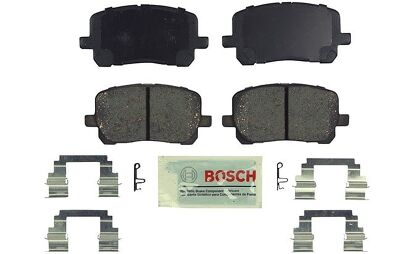
Check price at Amazon
Bosch presents another product: their Blue brake pad, which uses specialized friction materials like NAO-Ceramic and semi-metallic compounds tailored for specific platforms to ensure top-notch performance. The pads come equipped with OE-style multi-layer shims that provide excellent sound reduction, along with a protective coating designed to prevent rust and inhibit corrosion. Each set includes a hardware kit and synthetic lubricant. Additionally, some models feature slots and chamfers aligned with original equipment specifications, facilitating swift and straightforward installation.
These pads are perfect for daily drivers seeking good performance without breaking the bank. Despite undergoing the same rigorous testing and engineering processes as Bosch’s high-end braking components, they offer a more cost-effective solution.
Pros
Cost-effective, original equipment-inspired multi-layer shims, featuring both NAO-ceramic and semi-metallic composition, with a rust-inhibiting finish, comes with built-in lubricants.
Cons
The fit is quite snug on certain installations; even with the provided lubricant, it doesn’t help much.
All You Should Understand About Brake Pads for Your Vehicle

Photo Credit: Caracarafoto through Shutterstock
Just like we discussed earlier, brake pads play a crucial role in ensuring your vehicle's safety. These components are essential for effectively and swiftly decelerating your car, and you'll probably recognize when they need replacement due to a decline in braking efficiency. It's worth noting that there isn’t a set schedule for replacing these parts since their lifespan hinges on how much and what kind of driving you typically do. Nevertheless, many manufacturers suggest swapping out your brake pads every couple of years.
Next, we will delve deeply into all aspects of brake pads. This includes understanding various types available, identifying when they require replacement, as well as receiving advice on extending their lifespan.
What Are the Various Kinds of Brake Pads?
Contemporary cars roll off production lines equipped with various kinds of brake pads as default fittings. Certain car manufacturers might fit regular, non-sporty models with cost-effective pads to maintain lower prices. In contrast, high-performance automobiles typically arrive fitted with superior quality brake pads designed for better performance. It’s also possible some vehicles could utilize a mix of distinct brake pad types, prioritizing enhanced stopping power at the front end of the vehicle.
Here, we examine the most common varieties of brake pads available on the shelves at your nearby automotive supply shop or through an online retailer.
Semi-metallic Brake Pads
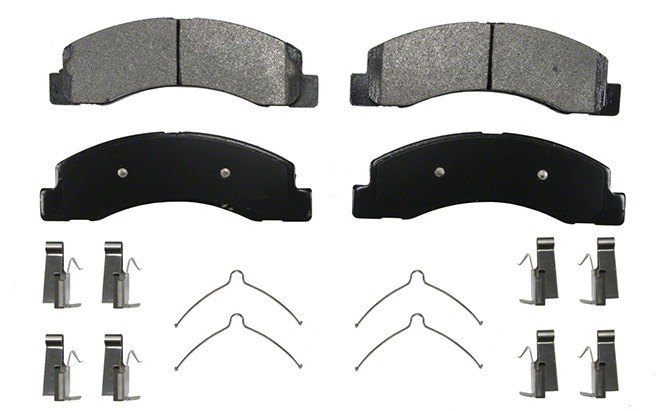
As ceramic brake pads become increasingly prevalent, semi-metallic brake pads remain the top choice for many. Primarily composed of metallic materials, these pads exhibit robustness and effectiveness along with commendable longevity. Generally, semi-metallic brake pads incorporate anywhere from 30% to 65% metal, often combined with elements like graphite, copper, or steel wool. This composition yields a braking surface capable of excellent thermal conductivity—crucial for maintaining optimal performance under various conditions.
Seek out brake pads with minimal copper content (such as Wagner's OE25, which contains under 0.5% copper) since copper is both an environmental contaminant and a possible health risk.
Pros
Excellent thermal conductivity, lasting toughness, substantial metallic composition
Cons
Generates a higher amount of brake dust compared to other pads and may produce more noise than alternative options.
Organic Brake Pads
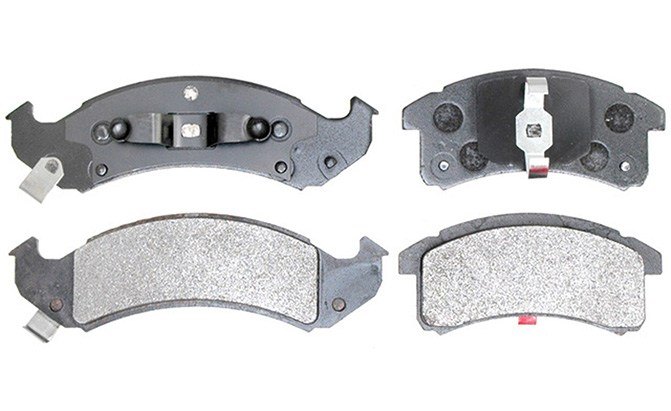
Organic brake pads are softer compared to semi-metallic ones since they contain less than 20% metal in their composition. They generate minimal noise during use and create lesser brake dust as opposed to higher performance alternatives. Additionally, some of these pads help reduce rotor wear, extending their lifespan.
Typically, you'll discover that organic pads are constructed using various fibers and resins designed to endure elevated temperatures; however, they usually have shorter lifespans compared to semi-metallic brake pads.
Pros
Reduce noise levels, minimize brake dust, and decrease wear on your rotors.
Cons
The pad tends to wear out faster compared to other brake pads because of its softer material, which doesn’t provide optimal performance.
Ceramic Brake Pads

As the newest offering in the brake pad marketplace, ceramic pads are gradually gaining traction among manufacturers. Made from ceramic fibers combined with various non-magnetic filament materials, these pads offer reliable performance across a broad spectrum of temperature ranges. Typically associated with reduced noise and minimal brake dust generation, ceramic pads do come at a higher price point compared to their counterparts. Additionally, they might produce greater noise levels under certain conditions.
The positive aspect is that many businesses now manufacture ceramic brake pads, making prices more competitive. Most of our suggestions lean towards ceramic brake pads because they offer a balanced mix of performance and cost-effectiveness, potentially outperforming semi-metallic pads in this regard.
Pros
Excellent performance, handles heat efficiently, reduced noise levels, produces less brake dust
Cons
Pricier compared to other varieties of brake pads
At What Point Should I Consider Replacing My Brake Pads?
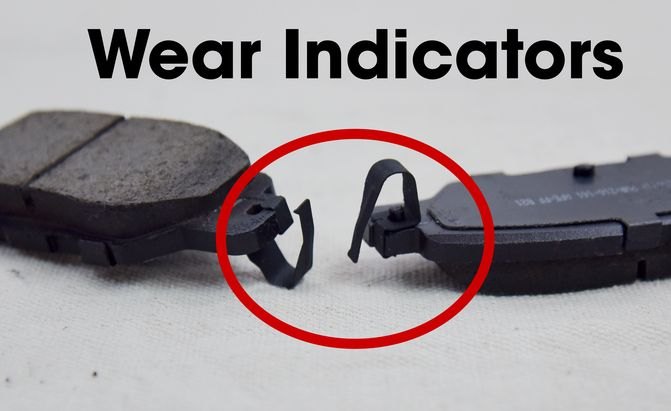
When brake pads become worn out, the wear indicator produces noise as it comes into contact with the rotor due to reduced pad thickness.
Brake pad wear indicators produce noise by scraping against the rotor once the pads have worn down. Photo Credit: David Trewan Adolphus / solusikaki.com.
Considering the wide range of brake pad types, car models, and individual driving habits around the globe, there isn’t one definitive rule about when you ought to change your brake pads. However, several indicators or practices can help signal when it might be necessary to switch to fresh ones.
Warning lights
Certain cars come with a brake pad alert mechanism, where the car informs you when it’s time to replace the pads. This feature operates using a basic sensor that triggers once the brake pads have worn down past a specific point. However, such systems aren’t universal; notably absent in many older and less expensive models.
Increased noise
A key indicator that you require new brake pads is if you hear screeching or squealing sounds during braking—or sometimes even while driving without applying the brakes. This usually means your brake pads have reached their limit; thus, you might be encountering direct metal-to-metal contact between the pad and the rotor. While this situation doesn’t cause immediate damage since small metal tabs scrape against the rotor merely producing noise, it signifies that your brake pads are nearing depletion. When you hit this point, approximately two-thirds of the brake pad material has been used up, so replacing them promptly is advisable before complete deterioration occurs.
Not all brake pads include wear indicators, and some need to be bent into place when you install them.
Vehicle drifting to one side
Many factors can lead to your car drifting towards one side; however, deteriorated brake pads might be responsible. Should your automobile veer sharply to one direction, ensure you inspect whether replacing the brake pads is necessary along with examining other possibilities like a deflated tire.
Vibrations
Should you encounter shaking when applying heavy brake pressure, it might indicate deteriorated or heat-damaged brake pads or possibly distorted rotors. In such cases, inspecting your braking system would be advisable to confirm whether any components require replacement.
Visual checks
You can easily check if your brake pads need replacement just by observing them directly. If visibility allows from the wheel area, look at the outer part of the brake pad that contacts the rotor; typically, when this section measures three millimeters or less, consider getting new ones.
Is It Possible for Me to Change My Brake Pads?
Similar to many routine vehicle upkeep activities, the response to that query hinges on your comfort level with performing auto repairs yourself. Swapping out brake pads is quite simple and direct, much like an oil change. Provided you possess fundamental tool skills and feel at ease tinkering with your automobile, this isn’t a challenging undertaking; numerous individuals opt for DIY pad replacements within the cozy confines of their garages.
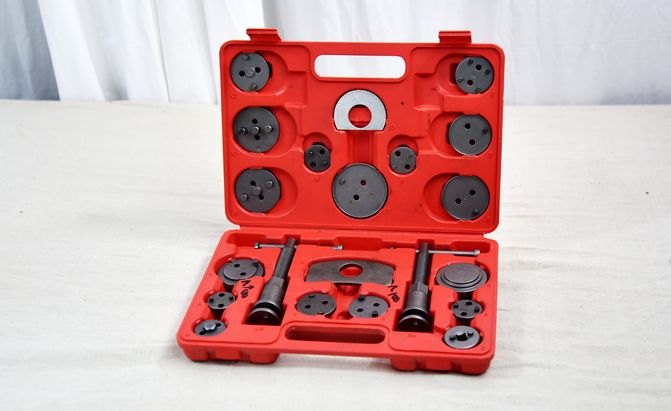
You might require a wind-back tool to replace your brake pads. These tools aren’t expensive.
You might require a wind-back tool to replace your brake pads. These tools aren’t expensive. Photo Credit: David Traver Adolphus / solusikaki.com.
Nevertheless, it necessitates appropriate tools and supplies. If you lack experience or confidence when handling automotive tasks, seek assistance from someone skilled or consider consulting an expert. Remember, brakes play a crucial role in ensuring vehicle safety, hence incorrect installation of brake pads should be avoided at all costs.
How long will my new brake pads last?
It's quite normal to be curious about the lifespan of your newly installed brake pads. However, there's no simple answer because it depends on factors like the type of brake pads you have and your driving habits. For instance, someone who frequently drives on uncongested freeways will likely see less wear on their brake pads compared to someone who spends hours navigating through constant stops and starts in urban areas.
It's crucial to consistently check the condition of your brake pads to determine when replacement is necessary.
Ways to Extend the Life of Your Brake Pads
While we cannot predict exactly how long your new pads will remain functional, here are some general guidelines to help maximize their lifespan.
- Attempt to predict when you'll need to slow down gently instead of braking abruptly.
- Ease off the speed when approaching intersections if you anticipate needing to halt, thus reducing the frequency of brake usage.
- Keep an eye on your speed because the quicker you travel, the harder you'll need to press the brakes when you have to decelerate.
- Keep an eye on the traffic in front of you; often, you can just ease up on the gas pedal rather than hitting the brakes when you predict a slowdown in the traffic ahead.
- Discard any unnecessary weight, as a heavier vehicle requires greater braking force.
It's important to note that you shouldn't deliberately aim to conserve your brake pads. Considering their price, you should utilize your brakes whenever needed for safety on the roads. To put it differently, avoid going to great lengths to maximize the lifespan of your brake pads if doing so compromises safe driving practices.
